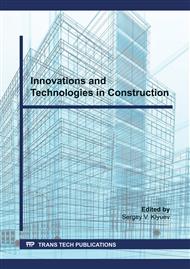[1]
L. B. Gezentsvey, A. M. Gorelyishev, I. V. Boguslavsky, I. V. Korolev, Road asphalt concrete, Transport, Moscow, (1985).
Google Scholar
[2]
P. V. Sakharov, About bituminous (asphalt) concrete, News of Russian Society of material testing. 1 (1914) 74.
Google Scholar
[3]
С. Richardson, The Modern Asphalt Pavement, J. Wiley and Sons, New York, (1907).
Google Scholar
[4]
B. S. Radovskiy, Modern requirements for rock material for asphalt mixes in the USA, Road machinery. (2009) 74–85.
Google Scholar
[5]
G. Wypych, Handbook of Fillers, ChemTec Publishing, Toronto, (1999).
Google Scholar
[6]
S. S. Inozemсev, A. N. Grishina, E. V. Korolev, Model of a complex nanomodifier for bituminous concrete, Regional architecture and engineering. 3 (2013) 15–21.
Google Scholar
[7]
Ya. N. Kovalev, Inter-phase contacts in bitumen-mineral systems and their strengthening, Science and Technique. 5 (2014) 3–9.
Google Scholar
[8]
R. Géber, I. Kocserha, L. A. Gömze, Influence of composition and grain size distribution on the properties of limestone and dolomite asphalt fillers, Materials Science Forum. 729 (2012) 344–349.
DOI: 10.4028/www.scientific.net/msf.729.344
Google Scholar
[9]
R. Muniandy, E. Aburkaba, L. M. J. Mahdi, Effect of Mineral Filler Type and Particle Size on Asphalt-Filler Mastic and Stone Mastic Asphalt Laboratory Measured Properties, Australian Journal of Basic and Applied Sciences. 7(11) (2013) 475–487.
DOI: 10.24200/tjer.vol10iss2pp13-32
Google Scholar
[10]
M. Wasilewska, D. Małaszkiewicz, N. Ignatiuk Evaluation of Different Mineral Filler Aggregates for Asphalt Mixtures, IOP Conf. Series: Materials Science and Engineering. 245 (2017) 022042.
DOI: 10.1088/1757-899x/245/2/022042
Google Scholar
[11]
R. Géber, A. Simon, I. Kocserha, A. Buzimov, Microstructural and rheological analysis of fillers and asphalt mastics, Journal of Physics: Conference Series. 790 (2017) 012009.
DOI: 10.1088/1742-6596/790/1/012009
Google Scholar
[12]
M. S. Lebedev, N. I. Kozhukhova, Rheological characteristics of bitumen mastic depending on composition and filler dispersity, Journal of Physics: Conference Series. 1045(1) (2018) 012026.
DOI: 10.1088/1742-6596/1045/1/012026
Google Scholar
[13]
A. I. Trautvain, V. V. Yadykina, E. S. Mulenko, Study of physical-mechanical properties of asphalt-concrete specimens on activated mineral powders of various compositions, Construction Materials and Products. 1(4) (2018) 44–50.
DOI: 10.34031/2618-7183-2018-1-4-44-50
Google Scholar
[14]
M. S. Lebedev, I. L. Chulkova, Study of rheological characteristics of bitumen composites with different fly ashes, Bulletin of BSTU named after V.G. Shukhov. 11 (2016) 47–52.
DOI: 10.12737/22365
Google Scholar
[15]
A. R. Pasandín, I. Perez, The influence of the mineral filler on the adhesion between aggregates and bitumen International, Journal of Adhesion and Adhesives. 58 (2015) 53–58.
DOI: 10.1016/j.ijadhadh.2015.01.005
Google Scholar
[16]
R. N. Traxler, The evaluation of mineral powders as fillers for asphalt, Proc. Assoc. Asphalt Paving Technologists. 8 (1937) 60–67.
Google Scholar
[17]
R. Xiong, L. Wang, X. Yang, F. Yang, Y. Sheng, B. Guan, H. Chen, Experimental investigation on related properties of asphalt mastic with activated coal gangue as alternative filler, International Journal of Pavement Research and Technology. 11 (2018) 725–732.
DOI: 10.1016/j.ijprt.2018.03.002
Google Scholar
[18]
H. Ziari, A. H. Korayem, M. Hajiloo, M. Nakhaei, A. Razmjou, H. Divandari Evaluating the effect of amorphous carbon powder on moisture susceptibility and mechanical resistance of asphalt mixtures, Construction and Building Materials. 152 (2017) 182–191.
DOI: 10.1016/j.conbuildmat.2017.06.036
Google Scholar
[19]
A. I. Trautvain, V. V. Yadykina, M. S. Lebedev, A. E. Akimov, Preliminary investigations of the conversion сhalk-stone as a mineral filler for asphalt-concrete mixtures, Bulletin of BSTU named after V.G. Shukhov. 6 (2018) 21–27.
DOI: 10.12737/article_5b115a5fca2155.86312327
Google Scholar
[20]
B. M. Harris, K. D. Stuart, Analysis of Mineral Fillers and Mastics Used in Stone Matrix Asphalt, Journal of the Association of Asphalt Paving Technologists. 64 (1995) 54–95.
Google Scholar
[21]
V. V. Yadykina, Management of formation processes and quality of building composites with the surface condition of dispersed raw materials: monograph, ASV,Moscow, (2009).
Google Scholar
[22]
A. M. Gridchin, V. V. Yadykina, D. A. Kuznetsov, M. A. Vysotskaya, A. V. Kuznetsov, Features of the surface properties of acidic mineral materials for asphalt concrete, Construction materials. 8 (2007) 56–57.
Google Scholar
[23]
Y. N. Kovalev, Activation technology road composite materials (scientific and practical bases), Belarusian Encyclapedia, Minsk, (2002).
Google Scholar
[24]
A. W. Hefer, Adhesion in bitumen-aggregate systems and quantification of the effects of water on the adhesive bond, Ph.D. dissertation, A&M University, USA, (2004).
Google Scholar
[25]
A. Bhasin, Development of methods to quantify bitumen-aggregate adhesion and loss of adhesion due to water,Ph.D. thesis, A&M University, Texas, USA, (2006).
Google Scholar
[26]
R. Taylor, Surface interactions between bitumen and mineral fillers and their effects on the rheology of bitumen-filler mastics, Ph.D. thesis, Univ. of Nottingham, UK, (2007).
DOI: 10.1201/9780203881200.ch42
Google Scholar
[27]
B. Delaporte, H. Di Benedetto, P. Chaverot and G. Gauthier Effect of ultrafine particles on linear viscoelastic of mastics and asphalt concretes, Transportation Research Record. 2051 (2008) 41–48.
DOI: 10.3141/2051-06
Google Scholar
[28]
H.Qiu, X.Tan, S. Shi, H. Zhang Influence of filler–bitumen ratio on performance of modified asphalt mortar by additive, Journal of Modern Transportation. 21(1) (2013) 40–46.
DOI: 10.1007/s40534-013-0002-2
Google Scholar
[29]
M. C. Liao, J. S. Chen, G. Airey, Characterization of viscoelastic properties of bitumen-filler mastics, Asian Transport Studies. 3(3) (2015) 312–327.
Google Scholar
[30]
Russian Standard 52129–2003, Mineral powders for asphaltic concrete and organomineral mixtures. Specifications, Russian Gosstroy, Moscow, (2004).
Google Scholar
[31]
V. B. Petropavlovskaya, T. B. Novichenkova, V. V. Belov, A. F. Buryanov Granulometric composition as criterion for regulating properties of dispersed systems, Construction materials. 1 (2013) 64–65.
Google Scholar
[32]
Y. V. Sokolov, G. I. Nadykto, Structure and properties of asphalt binder, Interuniversity proceedings «Application of cement and asphalt concretes in Siberia», SibADI, Omsk (1982) 100–107.
Google Scholar
[33]
G. I. Nadykto, V. D. Galdina, V. S. Prokopets, Structure and properties of asphalt binders based on mineral fillers of different nature, Construction materials. 5 (2010) 32–35.
Google Scholar


